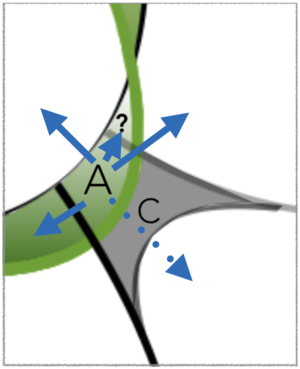Aporetic Turn
The aporetic turn refers to an authentic and legitimate domain of transition where we know what we don’t know. We will typically also not know what to do and need to understand that suspension of action is valid. Here we need to map the context and start to build evidence to support moving out of this state. It very much brings Cynefin dynamics front and centre as there are a number of ways (see diagram) that this state can be exited.
Name and history
The aporetic turn was added to Cynefin in 2019 and complements and extends the introduction of liminality in 2017. It took disorder that encompassed authentic and inauthentic behaviour and split it into aporetic (adjective of aporia) and confused, with authentic disorder becaming 'aporetic' and inauthentic disorder 'confused'.
This not only provides clarity of the states but it raises the validity of remaining in suspension when there are contradictions. This is in contrast to integrative solutions that seek an outcome without addressing the contradictions that exist. The aporia state requires meta-focus or aporetic contemplation to ensure that we acknowledge the contradictions that exist and that they should not be ignored or swept under the carpet. In a philosophical sense it acknowledges there is value in the journey and just not in the destination.
We are also implicaitly exploring the coherence of the domains, based on the tension between while acknowledging disequilibrium or the messy coherence that exists between them.
Landscape
The Aporetic turn involves a number of potential transitions and each of these needs to be considered as possible ways forward following mapping of the current context:
- Shift it into complex (the default) as there are multiple hypotheses, the validity of which can not be resolved within the available time for decision making. There is then a body of methods and tools that you can apply.
- Shift it into complicated, the issue is clearly one for which experts have the answer and we have access to the experts and/or we can commission research or analysis to discover what works.
- We’ve got no idea so we shift it into the complex-chaotic liminal zone and present the issue to a cognitively diverse audience for MassSense – a key SenseMaker® capability, to take one example (here we are relaxing constraints).
- The overlap into complicated identified by a question mark in the diagram is a very specific form of aporetic liminal change by bringing different experts into play in competing experiments or introducing expertise that cannot be challenged but is different. In the case of the later you could put a biologist onto an engineering program or similar. In the first, it is a case of exploring different experiments based on the views of the experts.
- Then there is the risky shift into Clear which means the risk of creating more confusion, shown with a dotted arrow. It is rarely safe to move from confusion to absolute order, better to shift to complicated first, the second options and it this proves to be stable then move down to clear.
References
Publications
Articles
- Leading and Managing through crisis HBR, 2020
